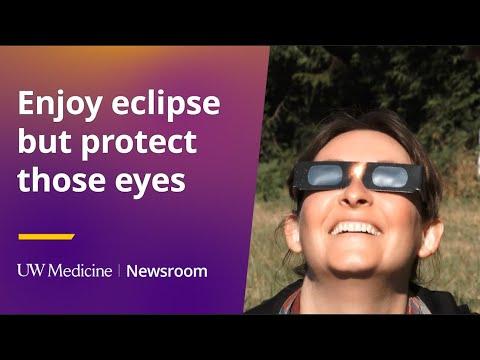
Why the solar eclipse can damage your eyes and how to see it safely
It seems like a simple warning that everyone surely got from a responsible adult in childhood. But each time the moon passes in front of the sun, creating an irresistible spectacle for millions around the world, Dr. Russ Van Gelder treats patients with sometimes serious damage caused by witnessing the event without proper protective eyewear. He saw at least six such patients after the 2017 eclipse.
“You can get damage even in just a few seconds of direct sun gazing, and if you're over 20 to 30 seconds, there's a high likelihood that you're going to end up with some damage,” said Van Gelder, professor and the Boyd K. Bucey Memorial chair of ophthalmology at the University of Washington School of Medicine and director of the Karalis Johnson Retina Center at South Lake Union. “Shorter durations can be reversible. Longer durations can be permanent, and you can end up with a blind spot right in the middle of your vision.”
The April 8 celestial event will be a full eclipse with a totality of about 2½ minutes for U.S. residents living along an arc from Texas through the Great Lakes region to Maine. Other states will see a partial eclipse with the moon obscuring a fraction of the sun’s surface. The eclipse is projected to be visible between 10:39 a.m. and 12:21 p.m. PT in Seattle with the maximum effect at 11:29 a.m.
Though the sun is 93 million miles away, its light particles, called photons, still pack quite a bit of energy following their eight-minute journey to the surface of our retinas.
“If you look straight into the sun, it's about a million billion photons per second that hit the surface of the retina,” Van Gelder said. “In 10 seconds, that's the equivalent energy of dropping a double-A battery on your retina from about a foot up. It's a lot of energy.”
Van Gelder illustrated the point by recalling how many children use magnifying glasses to burn leaves or grass as a scientific experiment. A magnifying glass has a focusing power of 10 to 20 diopters, a unit of measure that refers to the optical power of a lens. The eye has a focusing power closer to 60 diopters.
“So, if you look straight at the sun, you're essentially doing the same thing as burning leaves on the ground with a lens, but it's your retina that's burning,” Van Gelder said.
He also warned against using unfiltered telescopes, binoculars and phones to view the eclipse.
The safest way to view the eclipse is with a pair of glasses made with solar filters. Usually made of mylar and cardboard, they can be found online and at many major retailers. But beware of counterfeits. The glasses should be so dark that if you put them on indoors, the room will appear completely black. They should also come with a printed certification that includes the ISO number 12312-2:2015.
“The counterfeits can be pretty good, and they may have a lot of the same print,” Van Gelder said. “If you don’t see this number, that's a problem and you should have a question about the glasses.”
Those who won’t experience totality should wear protective glasses at all times while observing the sun. But viewers lucky enough to catch the eclipse in totality can remove the glasses while the moon completely engulfs the sun, a period of 2 minutes, 38 seconds this time around. They’ll be able to see the sun’s corona and solar flares launching from its surface while the moon blocks the most harmful rays.
“Suddenly the stars are out, and everything has gotten middle-of-the-night dark and you have the corona right around the moon,” said Van Gelder, who witnessed totality during the 2017 eclipse. “It's really an amazing thing to see, but do it safely.”
